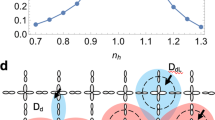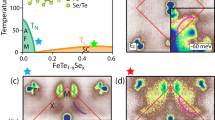Abstract
Electron correlation controls the properties of important materials such as superconducting and magnetoresistive transition metal oxides and heavy fermion systems. The role of correlation in driving metal-to-insulator transitions assumes further importance because many superconducting materials are located close to such transitions. The nature of the insulating ground state often reveals the dominant interactions in the superconductor, as shown by the importance of the properties of La2CuO4 in understanding the high-temperature-superconducting cuprates. The A3C60 alkali metal fullerides are superconducting systems in which the role of correlation in both the normal state and the superconducting pairing mechanism is controversial, because no magnetic insulator comparable to the superconducting materials has been identified. We describe the first example of a cubic C603− system with degenerate orbitals that adopts the Mott–Hubbard insulating localized electron ground state. Electron repulsion is identified as the interaction that is suppressed on the transition to metallic and superconducting behaviour in the fullerides. This observation is combined with ab initio calculations to demonstrate that it is the orbital degeneracy that allows the superconducting cubic A3C60 fullerides to remain metallic while provoking electron localization in systems with lower symmetry.
This is a preview of subscription content, access via your institution
Access options
Subscribe to this journal
Receive 12 print issues and online access
$259.00 per year
only $21.58 per issue
Buy this article
- Purchase on Springer Link
- Instant access to full article PDF
Prices may be subject to local taxes which are calculated during checkout





Similar content being viewed by others
References
Roy, A.S., Hoekstra, A.F.T., Rosenbaum, T.F. & Griessen, R. Quantum fluctuations and the closing of the coulomb gap in a correlated insulator. Phys. Rev. Lett. 89, 276402 (2002).
Sachdev, S. Spin and charge order in Mott insulators and d-wave superconductors. J. Phys. Chem. Solids 63, 2269–2276 (2002).
Rosseinsky, M.J. Recent developments in the chemistry and physics of metal fullerides. Chem. Mater. 10, 2665–2685 (1998).
Margadonna, S. & Prassides, K. Recent advances in fullerene superconductivity. J. Solid State Chem. 168, 639–652 (2002).
Gunnarsson, O. Superconductivity in fullerides. Rev. Mod. Phys. 69, 575–606 (1997).
Chakravarty, S. & Kivelson, S.A. Electronic mechanism of superconductivity in the cuprates, C60, and polyacenes. Phys. Rev. B 64, 1–9 (2001).
Iwasa, Y. & Takenobu, T. Superconductivity, Mott–Hubbard states, and molecular orbital order in intercalated fullerides. J. Phys. Condens. Matter 15, R495–R519 (2003).
Fleming, R.M. et al. Relation of structure and superconducting transition temperatures in A3C60 . Nature 352, 787–788 (1991).
Satpathy, S. et al. Conduction band structure of alkali-metal-doped C60 . Phys. Rev. B 46, 1773–1793 (1992).
Shirley, E.L. & Louie, S.G. Electron excitations in solid C60: Energy gap, band dispersions and effects of orientational disorder. Phys. Rev. Lett. 71, 133–136 (1993).
Bruhwiler, P.A., Maxwell, A.J., Nilsson, A., Martensson, N. & Gunnarsson, O. Auger and photoelectron study of the Hubbard U in C60, K3C60 and K6C60 . Phys. Rev. B 48, 18296–18299 (1993).
Lof, R.W., Veenendaal, M.A.v., Koopmans, B., Jonkman, H.T. & Sawatzky, G.A. Band-gap, excitons and coulomb interaction in solid C60 . Phys. Rev. Lett. 68, 3924–3927 (1992).
Gunnarsson, O., Koch, E. & Martin, R.M. Mott transition in degenerate Hubbard models. Phys. Rev. B 54, R11026–R11029 (1996).
Gunnarsson, O., Koch, E. & Martin, R.M. Mott-Hubbard insulators for systems with orbital degeneracy. Phys. Rev. B 56, 1146–1152 (1997).
Florens, S., Georges, A., Kotliar, G. & Parcollet, O. Mott transition at large orbital degeneracy: Dynamical mean-field theory. Phys. Rev. B 66, 1–2 (2002).
Han, J.E., Koch, E. & Gunnarsson, O. Metal-insulator transitions: Influence of lattice structure, Jahn-Teller Effect, and Hund's rule coupling. Phys. Rev. Lett. 84, 1276–1279 (2000).
Fullagar, W.K., Reynolds, P.W. & White, J.W. Lithium and sodium fullerides prepared in liquid ammonia. Solid State Commun. 104, 23–27 (1997).
Palstra, T.T.M. et al. Superconductivity at 40K in cesium doped Cs3C60 . Solid State Commun. 93, 327–330 (1995).
Maniwa, Y. et al. 13C NMR and static magnetic susceptibility in C60 superconductors: possible influence of Kondo impurity. Phys. Rev. B 58, 11603–11606 (1998).
Reed, C.A. & Bolskar, R.D. Discrete fulleride anions and fullerenium cations. Chem. Rev. 100, 1075–1120 (2000).
Tou, H., Maniwa, Y., Iwasa, Y., Shimoda, H. & Mitani, T. NMR evidence for Mott–Hubbard localization in (NH3)K3C60 . Phys. Rev. B 62, 775–778 (2000).
Dahlke, P., Denning, M.S., Henry, P.F. & Rosseinsky, M.J. Superconductivity in expanded C603− fullerides. J. Am. Chem. Soc. 122, 12352–12361 (2000).
Kitano, H. et al. Evidence for insulating behavior in the electric conduction of (NH3)K3C60 systems. Phys. Rev. Lett. 88, 096401 (2002).
Rosseinsky, M.J., Murphy, D.W., Fleming, R.M. & Zhou, O. Intercalation of ammonia into K3C60 . Nature 364, 425–427 (1993).
Takenobu, T., Muro, T., Iwasa, Y. & Mitani, T. Antiferromagnetism and phase diagram in ammoniated alkali fulleride salts. Phys. Rev. Lett. 85, 381–384 (2000).
Manini, N., Santoro, G.E., Corso, A.D. & Tosatti, E. Sensitivity of the Mott transition to noncubic splitting of the orbital degeneracy: Application to NH3K3C60 . Phys. Rev. B 66, 1–7 (2002).
Denning, M.S., Dennis, T.J.S., Rosseinsky, M.J. & Shinohara, H. K3+δC84 - higher fullerene analogues of the A3C60 superconductors. Chem. Mater. 13, 4753–4759 (2001).
Denning, M.S. et al. Close-packed C703− phases - synthesis, structure and electronic properties. J. Am. Chem. Soc. 124, 5570–5580 (2002).
Capone, M., Fabrizio, M., Castellani, C. & Tosatti, E. Strongly correlated superconductivity. Science 296, 2364–2366 (2002).
Han, J.E., Gunnarsson, O. & Crespi, V.H. Strong superconductivity with local Jahn-Teller phonons in C60 solids. Phys. Rev. Lett. 90, 167006 (2003).
Acknowledgements
We thank the referees for useful suggestions. The SQUID magnetometer was funded by the EPSRC (Engineering and Physical Sciences Research Council) UK, under GR/M91242.
Author information
Authors and Affiliations
Corresponding author
Ethics declarations
Competing interests
The authors declare no competing financial interests.
Supplementary information
Supplementary Fig. S1
Supplementary Fig. S2 (PDF 303 kb)
Supplementary Fig. S3
Supplementary Fig. S4
Rights and permissions
About this article
Cite this article
Durand, P., Darling, G., Dubitsky, Y. et al. The Mott–Hubbard insulating state and orbital degeneracy in the superconducting C603− fulleride family. Nature Mater 2, 605–610 (2003). https://doi.org/10.1038/nmat953
Received:
Accepted:
Published:
Issue Date:
DOI: https://doi.org/10.1038/nmat953
This article is cited by
-
Tuning the electronic states and superconductivity in alkali fulleride films
AAPPS Bulletin (2022)
-
Cooling quasiparticles in A3C60 fullerides by excitonic mid-infrared absorption
Nature Physics (2018)
-
Orbital disproportionation of electronic density is a universal feature of alkali-doped fullerides
Nature Communications (2016)
-
The strength of electron electron correlation in Cs3C60
Scientific Reports (2015)
-
Superconductivity at 5 K in alkali-metal-doped phenanthrene
Nature Communications (2011)



